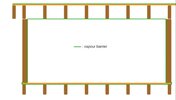- Joined
- 7 Mar 2024
- Messages
- 6
- Reaction score
- 0
- Country

Hello all...
I can't seem to find a definitive answer to my quandary so I thought I'd hit up the experts.
I'm currently building a garden room/she shed/he said/we said, never again.
So, I had a pretty solid foundation after knocking down the old garage and decided to build straight on top of it for the new build.
Standard build of 100mm timber frame, celotex/recticel insulation, 9mm osb skin, housewrap, etc.
I built a perimeter foundation of solid concrete blocks to sit the structure on.
Originally I intended to infill this with concrete for a totally solid internal floor, but financially and labour intensively, I've ended up building a timber subfloor instead.
The joists rest upon the perimeter blocks (woth intermittent blocks throughout the middle for support) and underneath there is a full covering of DPM, to suppress any damp from the original slab/concrete foundation.
So at this point, I'm ready to lay my subfloor boards, but I have no ventilation for the joists.
Although there are no signs of damp, and all subfloor is protected from penetrative damp, does anyone see this being an issue moving forward.
Walls and ceiling will be fully covered with vapour barrier attached to ground DPM, so effectively, entire internal structure will be sealed.
I can't seem to find a definitive answer to my quandary so I thought I'd hit up the experts.
I'm currently building a garden room/she shed/he said/we said, never again.
So, I had a pretty solid foundation after knocking down the old garage and decided to build straight on top of it for the new build.
Standard build of 100mm timber frame, celotex/recticel insulation, 9mm osb skin, housewrap, etc.
I built a perimeter foundation of solid concrete blocks to sit the structure on.
Originally I intended to infill this with concrete for a totally solid internal floor, but financially and labour intensively, I've ended up building a timber subfloor instead.
The joists rest upon the perimeter blocks (woth intermittent blocks throughout the middle for support) and underneath there is a full covering of DPM, to suppress any damp from the original slab/concrete foundation.
So at this point, I'm ready to lay my subfloor boards, but I have no ventilation for the joists.
Although there are no signs of damp, and all subfloor is protected from penetrative damp, does anyone see this being an issue moving forward.
Walls and ceiling will be fully covered with vapour barrier attached to ground DPM, so effectively, entire internal structure will be sealed.

